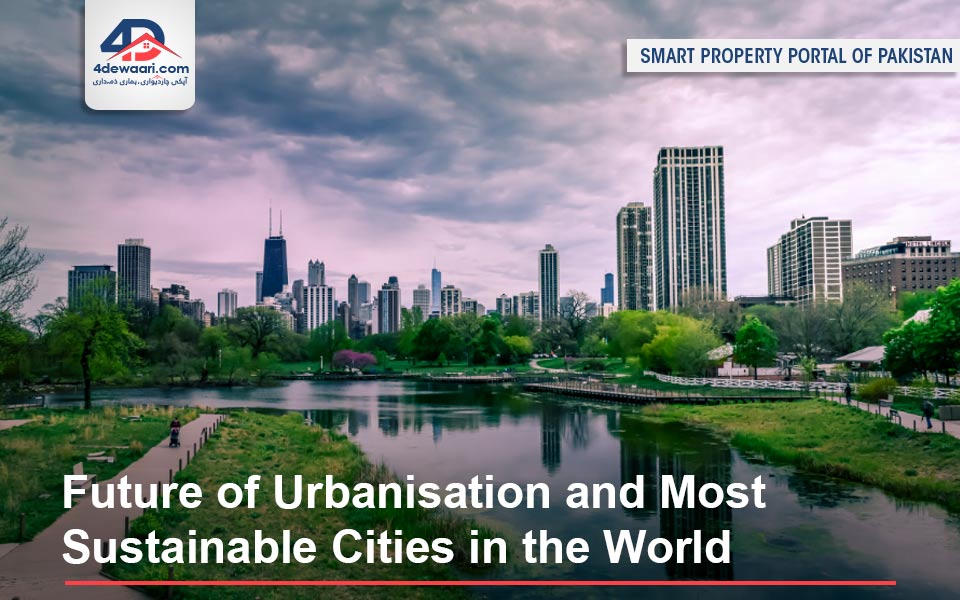Sustainable cities and urbanization are among the most important trends of our time, with cities expected to house 70% of the world's population by 2030. A significant increase in the percentage of people moving to cities has also been noted by the World Bank (WB), particularly in Asia and Africa. These migrants' main motivation is to look for ways to better employment and successful life. Governments and international organizations are striving to establish metropolitan regions that are more hospitable to wildlife by controlling urban development, i.e., sustainable urbanization. But what exactly does it mean, and how can we make it happen? To learn the answer to these queries and many more, keep reading. Most Sustainable Cities in the World where you can live and enjoy life.
Sustainable Urbanization
According to environmentalists and ecologists, sustainable urbanization is about creating a long-term vision for sustainable urbanized development. It means designing environmentally friendly, economically competitive, and socially inclusive cities. One way this can happen is through sustainable planning that considers environmental, economic, and social factors during the design process.
Need to Develop Sustainable Urbanization?
Numerous studies conducted by building and environmental professionals worldwide have concluded that unregulated urbanization poses huge problems. The most problematic ones are the expanding wealth inequalities, the degraded pollution, and the decaying infrastructure. In general, cities in the modern world struggle to accommodate the rapidly growing metropolitan population. Therefore, modern cities' design and construction concepts should encourage sociability and eco-friendly activities to achieve a harmonious balance between the environment and development. One of the main goals of creating sustainable cities is to create a people-centered urban setting where environmental habitats are preserved.
Read Also
Gwadar Free Zone The Gateway To Business
Sustainable Cities And Communities
The UN's Sustainable Development Goals are a plan for sustainable development over the next 15 years. The goal is for cities and communities worldwide to be sustainable by 2030. A project dubbed "Envision 2030" has been unveiled by the UN. It is focused on 17 objectives, all of which center on a plan for sustainable development. On the other hand, the UN's Envision 2030 particularly mentions sustainable cities and communities in its eleventh goal. It emphasizes the foundation and other requirements for creating and advocating eco-friendly architecture in the modern world.
We couldn't help but acknowledge that the 2030s might be a transformative decade when we look at the ground-breaking plan by numerous IT and infrastructure experts for the near future. It might alter the way that we think about urban development and living. We will also be able to adopt smart urban cities and communities. But what does it entails? Have a look below to know what is meant by smart, sustainable cities.
What is Meant by Smart, Sustainable Cities?
The concept of smart, sustainable cities is relatively new. But as a response to contemporary urbanization, it has been gaining favor. The goal is to create more intelligent, environmentally responsible, and socially just cities. Moreover, recent research has shown that a metroplex can be considered a sustainable community provided it meets the following requirements:
- Easy accessibility to essential services, such as those for education and health
- Certified sustainable supply of power and resource allocation that is effective
- Planning for vegetation in urban growth and infrastructure
- Availability of several urban open spaces, greenbelts, and public places
- A city infrastructure that encourages bicycle and walking
All these requirements can only be possible with the adoption of sustainable designs and infrastructure
Read Also
How the Construction Industry
Sustainable Design And Infrastructure
Currently, cities are home to 56% of the world's population. Cities house more than 4 billion people despite taking up only 3% of the planet's area, according to a study by the United Nations (UN), creating a grave disparity. Naturally, resource exploitation and environmental degradation are more likely to occur in overpopulated, densely populated metropolitan regions.
Sustainable architecture principles include:
- Energy usage is decreased in eco-friendly structures with carefully considered construction that maintains comfortable inside temperatures.
- A sustainable structure uses non-toxic materials for the interior and exterior, causing little to no environmental damage.
- A building that benefits from natural ventilation, sunlight, and greenery
- Self-sustaining systems for recovering and treating groundwater
Sustainable infrastructure, on the other hand, supports the following points:
- In an ideal world, a city with a sustainable infrastructure may have horizontal and vertical structures built using green architecture.
- The metropolitan region has made arrangements to preserve natural resources, particularly water.
- The idea of absorbent cities, which collect rainfall and avoid urban flooding, is also promoted by sustainable infrastructure.
Sustainable Cities of the future?
Many industrialized nations worldwide are planning and putting the concept of sustainability into practice. It is either to make existing metropolitan areas more livable or to rebuild cities completely. The globe has been astonished by the extraordinary futuristic visions of the cities listed below.
Saudi Arabia
The Kingdom of Saudi Arabia (KSA) proclaimed "The Line," and it quickly went viral online. It will be a 170 km long linear city, according to the Country's big project's official website. We have to acknowledge that it would be the most daring and exceptional technical challenge ever after looking at its stunning construction and artistic concepts.
Tokyo
It is the capital of Japan. Urbanization has always been difficult, but this highly developed metropolis has handled it skillfully. The local municipal council has announced a foundation for the city's expansion. The authorities plan to construct a high-tech, environmentally friendly urban city on the reclaimed ground in Tokyo's bay area. It is known as "Tokyo Bay ESG City." As the name implies, the main emphasis of this subsequent development will be on environmental, social, and governance (ESG) concerns. According to the minds behind this revolutionary plan, it would be the first ESG city in the world when it is finished in 2050.
To sum up
That's all we have to say on sustainable urbanization and the future of urbanization. As urban populations grow and more people move into cities, there is an increasing need for sustainable cities. The future of urbanization depends on how we build smarter, greener cities that cater to the needs of their citizens and are not focused solely on economic growth. What do you think about smart, sustainable city initiatives? Are these going to be profitable strategies? Please share your valuable thoughts with us!















